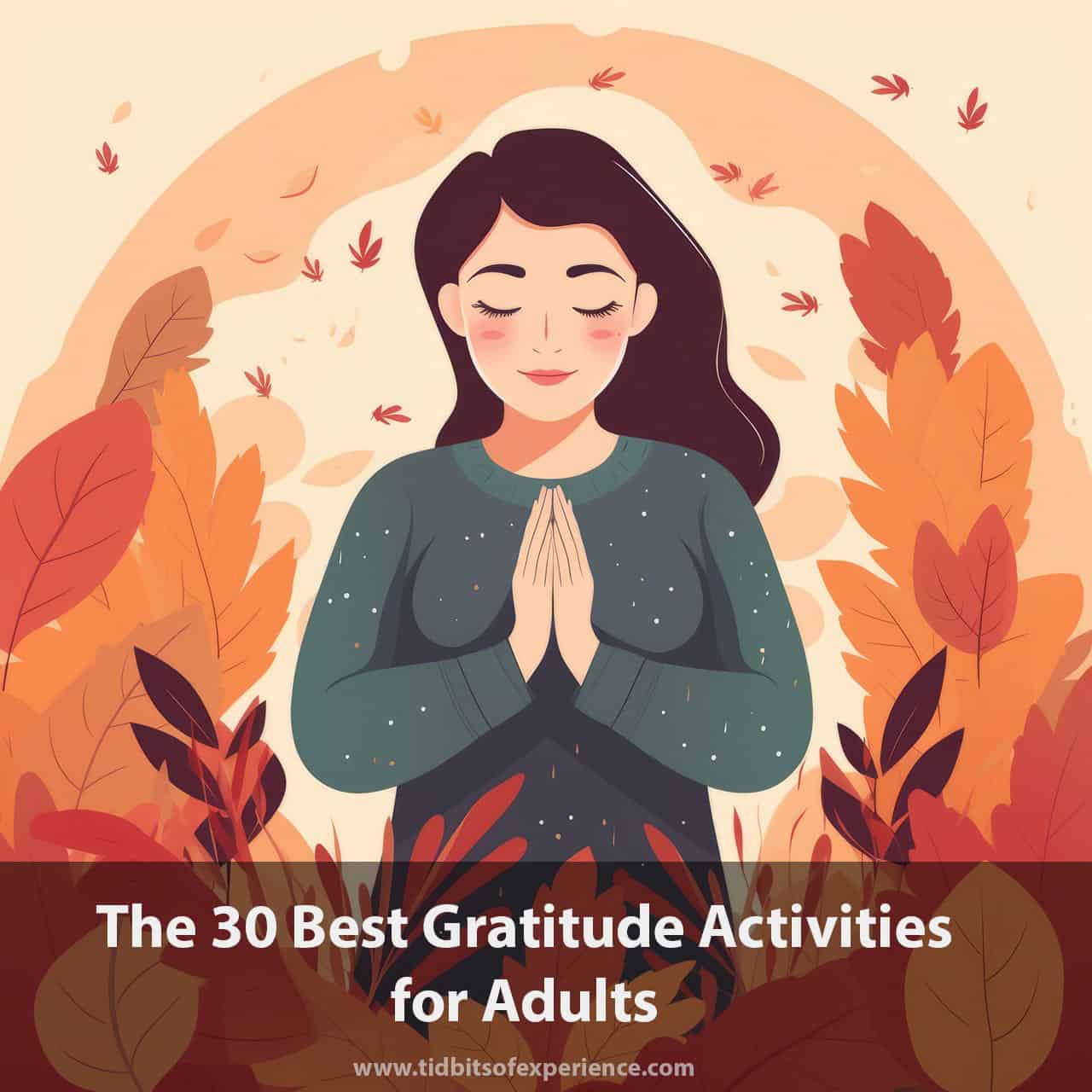In today’s fast-paced world, it’s easy to overlook the simple things we can be grateful for. Practicing gratitude has been proven to significantly benefit our mental health and overall well-being.
This blog post will explore 30 engaging and creative gratitude activities tailored to adults to help improve mood, reduce stress and anxiety, foster positive relationships, and enhance daily life experiences.
Gratitude Activities For Adults (Key Takeaways)
- Practicing gratitude significantly benefits mental health and well-being, including improved mood, reduced stress and anxiety levels, and better relationships with others.
- There are numerous engaging and creative gratitude activities tailored specifically for adults to cultivate feelings of appreciation, such as journaling, meditation, and expressing gratitude through letters or small acts of kindness towards others.
- Taking walks or hikes in nature, creating a gratitude jar or collage, and practicing grateful breathing exercises are other fun ways to incorporate gratitude into daily routines that promote emotional maturity and mindfulness.
- Incorporating regular expressions of thankfulness into everyday tasks like making breakfast can positively change overall mental health while helping individuals develop resilience and an optimistic outlook on life over time.
Table of Contents
The Importance Of Practicing Gratitude For Mental Health And Well-being

Practicing gratitude has improved mood and emotional well-being, reduced stress and anxiety, and enhanced relationships and social connections.
Improved Mood And Emotional Well-being
Practicing gratitude has been linked to improved mood and emotional well-being, allowing us to shift our focus from negative thoughts to positive aspects of our lives.
For instance, when we maintain a daily gratitude journal or engage in regular acts of kindness, we become more aware of the moments that bring joy and contentment.
Incorporating gratitude activities into your everyday routines may even contribute to increased levels of serotonin – the “feel-good” neurotransmitter responsible for regulating mood, appetite, sleep, and memory.
As you train your mind to recognize and appreciate life’s small blessings more frequently, you’ll cultivate healthier thought patterns that uplift your spirits and dramatically impact your overall mental health.
Reduced Stress And Anxiety
Practicing gratitude can significantly reduce stress and anxiety levels, improving overall mental health. One of the reasons behind this is that focusing on positive aspects of life helps shift our attention away from negative thoughts, eventually reprioritizing our mindset.
For instance, take a moment each day to recall three things you’re grateful for—whether it be the aroma of your morning coffee or a kind act someone extended towards you.
Incorporating fun gratitude activities (such as journaling or creating a gratitude jar) into your daily routine fosters an increased sense of appreciation and releases feel-good chemicals such as dopamine and serotonin in the brain.
These neurotransmitters contribute to feelings of happiness and relaxation while combating anxiety-inducing cortisol levels.
Better Relationships And Social Connections
Practicing gratitude has the power to enhance relationships and foster stronger social connections. You create a positive atmosphere that strengthens bonds with friends, family, and coworkers by appreciating and expressing thankfulness for others.
One study found that when individuals expressed gratitude towards their partner – whether through verbal affirmations or small acts of kindness – both partners experienced higher satisfaction in the relationship.
This is because acknowledging and valuing what we love about our loved ones boosts our happiness levels and encourages them to reciprocate those feelings.
In addition to improving romantic relationships, practicing gratitude can help deepen friendships or even form new ones. When you recognize how much others contribute to your life’s joy, engaging more deeply with those around you is easier – opening up opportunities for long-lasting bonds built on respect and admiration.
30 Fun And Creative Gratitude Activities For Adults’ Mental Health And Well-being

The article includes many gratitude activities for adults, such as creating a gratitude jar or board, writing gratitude letters, practicing mindful gratitude meditation, and going on gratitude walks or hikes.
Gratitude Journaling
One powerful way to practice gratitude is through journaling. Writing down the things we’re grateful for can help us cultivate a sense of gratitude, improve our mood and emotional well-being, and reduce stress and anxiety.
To start, simply set aside some time each day or week to reflect on the things in your life that bring you joy and appreciation, no matter how small they may seem.
To make the most of your gratitude journaling practice, consider setting specific prompts or questions to guide your reflections.
Mindful Gratitude Meditation
Mindful gratitude meditation is a powerful technique that can help cultivate feelings of gratitude and positivity. To practice this form of meditation, you must focus on the present moment and express thanks for what you have in your life.
Through regular practice of mindful gratitude meditation, studies show that individuals experience improved overall well-being and reduced stress and anxiety levels. In fact, researchers found that people who regularly practiced grateful thinking were more likely to feel happier and be more satisfied with their lives.
Expressing Gratitude To Others
One of the most powerful ways to practice gratitude is by expressing it directly to others. This can be as simple as saying “thank you” or writing a heartfelt note. Expressing gratitude not only makes the other person feel appreciated, but it also has significant benefits for our own mental health and well-being.
There are countless ways to express gratitude to those around us. It could be thanking a coworker for their help on a project, telling a loved one how much they mean to us, or even sending an email or letter of appreciation to someone who has positively impacted our lives.
Practicing Gratitude In Nature
Connecting with the great outdoors can be a powerful way to practice gratitude. Whether you take a walk in the park, hike, or simply sit and meditate outside, being surrounded by nature can help you cultivate feelings of appreciation for all around you.
This connection has been shown to have numerous mental health benefits, including reducing stress and anxiety and boosting mood. Some ways to practice gratitude in nature include taking time to appreciate the beauty of your surroundings, reflecting on how they make you feel, or even thanking nature itself for providing such a nourishing environment.
Creating A Gratitude Jar Or Board
Another fun and engaging way for adults to practice gratitude is by creating a gratitude jar or board. This activity involves writing down things that you are grateful for on small pieces of paper and putting them in a jar or on a corkboard.
This simple activity helps individuals focus on the positive aspects of their lives instead of dwelling on negative thoughts and emotions. It also serves as a visual reminder to be thankful for what they have and not take things for granted.
Gratitude Letter Writing
Gratitude letter writing is a powerful and heartfelt way of expressing appreciation towards others. It involves writing a sincere message or letter to someone who has positively impacted your life, expressing gratitude for their kindness, support, or friendship.
This activity can incredibly benefit mental health and well-being, fostering positive emotions such as joy, happiness, and optimism. In fact, research shows that regularly practicing gratitude can increase feelings of happiness by up to 25%.
To get started with gratitude letter writing, think about someone in your life who you are grateful for and why. Write them a genuine message thanking them for specific things they have done for you or how they have impacted your life.
Examples include expressing thankfulness towards family members who have supported you during tough times, friends who have offered words of encouragement when you needed it most, or colleagues whose hard work has helped make your job easier.
Gratitude Walks Or Hikes
One of the most effective ways to practice gratitude is by walking or hiking in nature. Being surrounded by the beauty of nature can help us appreciate our surroundings, and being physically active can also boost our mood.
During your walk or hike, take time to notice and reflect on all the things you are grateful for – perhaps it’s the sound of birds chirping, a breathtaking view, or simply having strong legs that enable you to enjoy this experience.
To make this activity even more special, consider inviting a friend along with you to share in your appreciation of nature and each other’s company. As a bonus, studies have shown that spending time outdoors with others positively benefits mental and physical health by decreasing cortisol (a stress hormone) levels in people who spend time together outside.
Gratitude Collage Making
Another fun and creative way to practice gratitude is by making a gratitude collage. This activity involves collecting pictures, images, and words representing things you are grateful for and arranging them on a board or paper.

The process of creating a gratitude collage allows you to focus on the positive aspects of your life while also giving you a physical reminder of all the good things in your life.
Looking at your collage regularly can help shift your mindset towards gratitude and foster a sense of appreciation for what you have.
Gratitude Scavenger Hunts
Gratitude scavenger hunts are a fun and creative way to practice gratitude for adults’ mental health and well-being. This activity encourages individuals to explore their environment and find things to be grateful for.
It can be as simple as taking a walk outside and finding five things to appreciate, or it can be more elaborate with a planned scavenger hunt with specific items to search for.
The great thing about gratitude scavenger hunts is that it promotes emotional maturity, mindfulness, and positive thinking in individuals of all ages. Children can also participate, making it an excellent family activity.
Focusing on the good around us shifts our mindset from negative to positive thoughts. According to research, gratitude becomes a habit when practiced consistently, leading to improved mood, reduced stress levels, and better relationships with others.
Giving Gratitude In Your Daily Routines
Another way to practice gratitude is by integrating it into your daily routines. This can include taking a moment each day to reflect on what you’re thankful for, whether it’s during your morning cup of coffee or before bedtime.
You can also incorporate gratitude into simple tasks like making breakfast, practicing yoga, or even brushing your teeth.
Research has shown that regularly expressing gratitude can boost happiness levels and improve overall mental health. By finding small moments throughout the day to give thanks for what we have, we shift our perspective towards positivity and develop a sense of appreciation for even the most mundane aspects of our lives.
Grateful Breathing Exercises
Grateful breathing exercises are a simple and effective way to incorporate gratitude into your daily life. To practice, simply take a few deep breaths and focus on exhaling feelings of gratitude and any negative emotions or stress.
You can also visualize inhaling positive energy or light and exhaling any tension or negativity in your body.
For example, try practicing grateful breathing when you wake up each morning or before going to bed at night. You can also incorporate this exercise into other activities, such as yoga or meditation, for an extra sense of relaxation and mindfulness.
Gratitude Rock Or Crystal Collection
Collecting gratitude rocks or crystals is a fun and simple way to incorporate gratitude into your daily routine. Find rocks or crystals that resonate with you, and keep them in a special spot where you will see them often.
This practice can help shift your focus from what is lacking in your life to all the positive aspects worth acknowledging. It’s also an easy way to connect with nature and add some beauty to your living space.
Gratitude Affirmations
Gratitude affirmations are a powerful tool to cultivate a sense of gratitude and positivity. By repeating positive statements about what we appreciate in our lives, we can train our brains to focus on the good instead of the negative.
According to studies, regularly practicing gratitude through affirmations has been linked with improved mental health, reduced stress levels, and increased happiness. To incorporate this practice into your daily routine, try writing out a few affirmations each morning or reciting them aloud before bed.
Gratitude For Your Senses
Our senses play a vital role in our everyday experiences, whether enjoying the aroma of freshly brewed coffee or feeling the sun’s warmth on our skin. Practicing gratitude for our senses is an excellent way to boost mental well-being and overall happiness.
One of the best ways to do this is by taking a moment to appreciate each sense individually and expressing thanks for what they bring into our lives. For instance, try taking a walk through nature and paying attention to how your surroundings engage all your senses, from the sound of birds chirping to the scent of blooming flowers.
Research has shown that gratitude improves mood, reduces stress and anxiety levels, boosts relationships with others, and increases overall satisfaction with life.
Gratitude For Moments Of Joy
Appreciating the moments of joy in our lives is an important aspect of practicing gratitude. Whether it’s a beautiful sunset, a successful work project, or spending time with loved ones, focusing on these positive experiences can help boost our overall well-being.
One way to practice gratitude for moments of joy is through journaling. Writing down specific experiences that brought us joy allows us to relive those happy memories and appreciate them even more.
Another option is to share these moments with friends or family members by telling them how much their presence or actions mean to us.
Gratitude For Challenges And Growth
Expressing gratitude for challenges and growth can be a powerful way to boost personal development and well-being. It’s easy to take the good things in life for granted, but by focusing on the lessons learned from difficult experiences, we can cultivate resilience and a deeper sense of appreciation.
For example, reflecting on how past struggles have made us stronger or more compassionate can help us reframe negative situations in a more positive light. This type of gratitude exercise also encourages a growth mindset that emphasizes progress over perfection.
Research has shown that practicing gratitude regularly benefits mental health and well-being. A 2018 study published in the Journal of Psychosomatic Research found that expressing gratitude was associated with lower levels of perceived stress and depressive symptoms in college students.
Additionally, another study published in the Journal of Personality found that people who kept daily gratitude journals reported higher levels of happiness than those who didn’t practice any form of gratitude exercise.
Gratitude For Personal Accomplishments
Take a moment to reflect on your personal accomplishments. It’s easy to get caught up in the hustle and bustle of daily life and forget about all the amazing things you’ve achieved.
Practicing gratitude for your accomplishments can boost your confidence, self-esteem, and overall sense of well-being.
Whether it’s getting that promotion at work or simply finishing a book you’ve been meaning to read, acknowledging your personal victories is important. By focusing on what you have achieved rather than what still needs to be done, you cultivate a positive mindset that can help propel you toward future success.
Gratitude For Opportunities And Experiences
Practicing gratitude for opportunities and experiences is a powerful way to cultivate a sense of appreciation for the good things in life. When we acknowledge the positive events and moments that have shaped us, we understand who we are and what we can accomplish.
One way to practice gratitude for opportunities and experiences is by keeping track of them in a journal or on a board. For example, you may want to write down some highlights from your recent travels, accomplishments at work or school, or personal achievements.
Reflecting on these experiences regularly can help build feelings of satisfaction and contentment that support our overall well-being. Another approach is to use visualization techniques during meditation sessions; focusing on past successes can foster greater self-awareness, resilience, and optimism about the future.
Gratitude For Personal Talents And Skills
Expressing gratitude for personal talents and skills is a powerful way to boost self-esteem, motivation, and overall satisfaction with life. Take some time to reflect on what you are good at, whether it’s a specific hobby or talent or a more general skill like being a great listener or problem solver.
We can develop greater confidence and resilience by focusing on what we excel at instead of dwelling on our shortcomings. In addition, acknowledgment of one’s abilities promotes proactive behavior that contributes positively to society.
Gratitude For Simple Pleasures
Gratitude for simple pleasures is about taking the time to appreciate the small things in life. It could be a good cup of coffee, a warm shower, or a beautiful sunset – anything that brings you joy and contentment.
Focusing on these moments can help shift your mindset and improve your overall well-being.
Practicing gratitude for simple pleasures doesn’t need to be complicated, either. It can be as simple as pausing for a moment during your day to reflect on something you are grateful for.
Maybe it’s the feeling of fresh air on your skin during a walk or the taste of a delicious meal.
Gratitude For Acts Of Kindness
Practicing gratitude for acts of kindness is a powerful exercise that uplifts our spirits and strengthens our connections to others. It involves taking time to appreciate the many little ways people show us kindness, whether it’s a coworker lending a helping hand on a project or someone offering us words of encouragement when we need them most.
One effective way to practice gratitude for acts of kindness is by keeping a journal where you jot down specific examples of deeds others have done for you each day.
This simple practice helps improve your mood and sense of well-being and strengthens your social ties with those around you. Another way to show appreciation for acts of kindness is through writing thank-you notes or sending messages expressing your heartfelt thanks.
Gratitude For Laughter And Humor
Laughter is often referred to as the best medicine and for good reason. Practicing gratitude for humor and laughter can improve mental health and well-being in many ways.
Laughter has been shown to reduce stress hormones, enhance mood, boost the immune system, and even relieve pain.
One way to practice gratitude for laughter is by actively seeking out opportunities to laugh. Spend time with people who make you laugh or watch comedies that make you giggle.
Try incorporating silly moments into your daily routine or reading joke books during breaks at work or school.
Gratitude For Relationships And Connections
Taking a moment to show gratitude for the relationships and connections in our lives can have a significant impact on our mental well-being. Whether it’s expressing appreciation towards friends, family members, or colleagues, acknowledging these important connections can help foster positive emotions and improve social bonds.
Activities such as writing letters of thanks, spending quality time with loved ones, or simply telling someone how much they mean to you are all ways of promoting feelings of gratitude and cultivating stronger relationships.
Studies have found that showing gratitude towards others has been linked to increased happiness levels, better sleep quality, and reduced symptoms of depression.
Gratitude For Self-care And Self-love
Practicing gratitude for self-care and self-love involves appreciating yourself for who you are, your strengths, and your efforts to improve. It is easy to criticize ourselves or focus on our flaws, but taking a moment to acknowledge and be grateful for our accomplishments and positive qualities helps build confidence, inner peace, and self-esteem.
Simple ways to practice gratitude for self-care include writing down daily affirmations such as “I am enough,” “I am strong,” or “I love myself.” Additionally, treating yourself with kindness by setting boundaries, practicing healthy habits like exercise and meditation, or doing something that brings you joy also helps cultivate a sense of gratitude towards oneself.
Gratitude For Your Home And Belongings
Showing gratitude for our home and belongings is a great way to cultivate an appreciation for the things we often take for granted.
One way to practice gratitude in this area is by creating a “gratitude tour” of your home. As you move through each room or space, intentionally look around and notice all of the things you’re grateful for – whether it’s cozy blankets on the couch, family photos on display, or even just having access to clean water.
Gratitude For Your Job Or Career
It’s important to show gratitude for our work and the opportunities our jobs or careers afford us. One way to practice this is by reflecting on what you appreciate about your job, whether it’s a supportive coworker, interesting tasks, or even just a steady income.
Research shows that focusing on gratitude towards one’s job can improve performance and engagement. When we feel grateful for our work, we are more likely to be motivated and productive, leading to greater career success.
Additionally, practicing gratitude can help reduce stress and improve mental health overall.
Gratitude For Your Health And Wellbeing
Practicing gratitude for your health and well-being can significantly impact your physical and mental state. Take a moment to appreciate the fact that you wake up each day feeling healthy and able-bodied.
Being conscious of this fact can help improve mood, reduce anxiety, and increase happiness.
Studies show that practicing gratitude through journaling or expressing verbal words of thankfulness towards your body can lead to improved self-esteem, lower stress levels, fewer symptoms of depression and anxiety disorders, and better immune functioning due to less inflammation in the body.
Gratitude For Your Spirituality Or Religion
Expressing gratitude for your spirituality or religion can be a powerful way to boost mental health and well-being. Whether you find solace in prayer, meditation, or attending religious services, taking the time to appreciate these practices can increase feelings of peace and connection with something greater than yourself.
Research has shown that individuals who practice gratitude for their faith experience enhanced levels of positive affect, meaning they feel more joyful and content overall.
Additionally, studies have found that people who regularly attend religious services report higher levels of life satisfaction and improved physical health than those who do not practice spirituality or religion.
Gratitude For The Present Moment
Being present in the moment is one of the greatest gifts we can give ourselves. When we’re constantly thinking about the past or the future, we miss out on what’s happening around us.
One way to practice gratitude for the present moment is through mindfulness meditation techniques. This involves focusing your attention on your breath or other sensory experiences without judgment, which helps you become more aware of and grateful for all surrounding you.
Another way to show gratitude for the present moment is by noticing small things that bring joy throughout your day, like a beautiful sunset or a kind word from a coworker.
Tips For Making Gratitude A Regular Practice

To make gratitude a regular practice, start small and build momentum by focusing on one thing each day; practice gratitude regularly through your preferred method of expression; be mindful of the present moment to stay in tune with what you are grateful for, and set reminders or cues for gratitude to help keep it top of mind.
Start Small And Build Momentum
When it comes to practicing gratitude, starting small and building momentum is crucial. It can be overwhelming to immediately jump into a full-blown daily gratitude practice, which may lead some adults to give up on the idea.
From there, gradually increase your focus on gratitude by incorporating additional exercises from the list of 30 activities shared in this article. For example, create a gratitude jar where you write down something you’re grateful for each day, and at the end of the week, read all your messages of gratitude out loud to yourself or share them with someone else.
Practice Gratitude Regularly
Incorporating gratitude into our daily lives can significantly impact our overall well-being. Making it a regular practice rather than just an occasional activity is important.
This consistent practice can train our brains to focus on the positive, helping us feel more content and fulfilled in life. One way to make gratitude a regular habit is by setting aside time each day to reflect on what we’re thankful for.
Starting small with just one or two things we appreciate about ourselves or others can gradually build momentum toward cultivating a greater sense of gratitude in everyday life.
Studies show that those who regularly practice gratitude tend to have higher happiness levels, better relationships with others, and less stress and anxiety than those who don’t prioritize this practice (source).
Be Mindful Of The Present Moment
Another key aspect of incorporating gratitude into your daily life is to be present and mindful in the moment. By focusing on the present moment, you can fully appreciate and give thanks for all the blessings in your life, big or small.
Being mindful allows you to shift your focus from what could go wrong, or you don’t have to be grateful for what you have.
For example, when drinking a cup of coffee, take a moment to savor its taste and aroma instead of rushing through it while thinking about your next task. You can also practice mindfulness during walks by paying attention to your surroundings – noticing the colors of leaves or flowers, feeling the warmth of sunlight on your skin, and listening to birds chirping – all while giving thanks for these experiences.
Set Reminders Or Cues For Gratitude
To make gratitude a regular practice, setting reminders or cues can be incredibly helpful. It’s easy to let the stress of daily life overshadow our sense of gratitude, so it’s important to find ways to bring it back into focus.
You can try setting an alarm on your phone for a specific time each day to take a moment and reflect on what you’re grateful for. Or, place visual cues around your home or workspace as reminders – this could be anything from post-it notes with positive affirmations to photos of loved ones or moments that evoke feelings of gratitude.
By incorporating reminders and cues into your daily routine, you’ll be more likely to prioritize gratitude and experience its benefits.
Frequently Asked Questions (About Gratitude Activities For Adults)
What are some examples of gratitude activities for adults that promote mental health and well-being?
Examples of gratitude activities for adults include keeping a daily gratitude journal, practicing mindfulness through meditation or breathing exercises, expressing appreciation towards others by writing thank-you notes or giving compliments, and volunteering in the community to help those less fortunate.
How can practicing gratitude improve my mental health and overall well-being?
Practicing gratitude has been shown to reduce stress levels, increase positive emotions like joy and happiness, improve sleep quality, enhance relationships with others, boost self-esteem and resilience, and lead to a more optimistic outlook on life.
Can anyone practice gratitude, or is it only effective for certain individuals?
Gratitude practices can benefit anyone regardless of age or background. In fact, studies have shown that people who regularly practice gratitude experience more significant improvements in their mental health compared to those who do not incorporate these practices into their daily lives.
Are there any potential downsides to practicing gratitude to improve mental health?
There are no known downsides associated with practicing gratitude as long as it is done appropriately. However, if individuals use this approach as a replacement for seeking professional help when dealing with serious mental health issues such as depression or anxiety disorders – they may not see the desired results they seek without additional support from licensed professionals like counselors/therapists who specialize in treating these types conditions effectively over time amidst multiple factors involved beyond simple reflections surrounding gratefulness alone.
Conclusion
In conclusion, practicing gratitude is a simple yet powerful way to improve our mental health and well-being. The 30 fun and creative gratitude activities outlined in this article are designed to help adults cultivate gratitude for the big and small things in life.
From gratitude journaling to mindful meditation, expressing gratitude to others, and walking in nature, there are numerous ways to incorporate gratitude into our daily routine.
By taking time every day or week to appreciate what we have, we can increase our happiness level, reduce stress and anxiety, strengthen relationships with loved ones, and lead a more fulfilled life.
